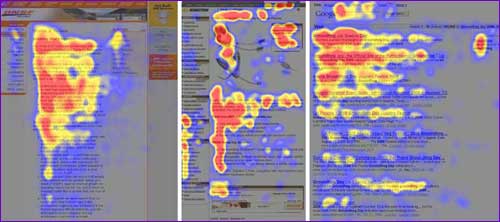V. Accessible Content
5.1. How do User Read on the Internet
5.1.1. “F for Fast...
...That’s how users read your precious content” (Nielsen, 2006).
This is one of the findings Jakob Nielsen highlighted from Nielsen Normal Group’s eye tracking researches. Indeed, Internet users generally do not have the time, or do not want (for various reasons, such as the lack comfort), to read online content.

Figure 5.1: Heat maps from user eye tracking studies of three websites.
Note: The areas where users looked the most are coloured red; the yellow areas indicate fewer views, followed by the least-viewed blue areas. Gray areas didn’t attract any fixations (Nielsen, 2006).
Nielsen put in evidence that users tends to scan page rather than to read them, using headings as beacons to guide their eyes. Nielsen identified a dominant reading pattern that has the following characteristics:
- “Users first read in a horizontal movement, usually across the upper part of the content area. This initial element forms the F’s top bar.
- Next, users move down the page a bit and then read across in a second horizontal movement that typically covers a shorter area than the previous movement. This additional element forms the F’s lower bar.
- Finally, users scan the content’s left side in a vertical movement. Sometimes this is a fairly slow and systematic scan that appears as a solid stripe on an eyetracking heat map. Other times users move faster, creating a spottier heat map. This last element forms the F’s stem” (Nielsen, 2006).
The implication for the developers of this F-shaped patterns are multiple, but the most important are certainly that user do not read the whole content of a page, they generally focus on the two firsts paragraphs, and more especially the headings. When writing the content of a page, it is better to use the “inverted pyramid” style of writing, used by most news papers. This style of writing consists in offering a short summary of the article before the actual article. The advantages of this style are that readers know exactly what is the article about, what are its findings and important points; which can confirms that the article is well about the subject that matters for them, or not.
Then, it will be important to give eye catching and meaningful headings within the text, as these will lead the eyes of the reader. Nielsen demonstrates with the example of an article from the New York Times entitled “Coping With the Tall Traveler’s Curse” that with online contents, headings cannot be written in the same way as for print content. Indeed, in this example, “the first three words have no information-carrying content. On the Web, you must start with words like "tall traveler" because users often scan down the left part of a list of items. They never see the last words in a link unless the first few words attract their attention” (Nielsen, 2008).